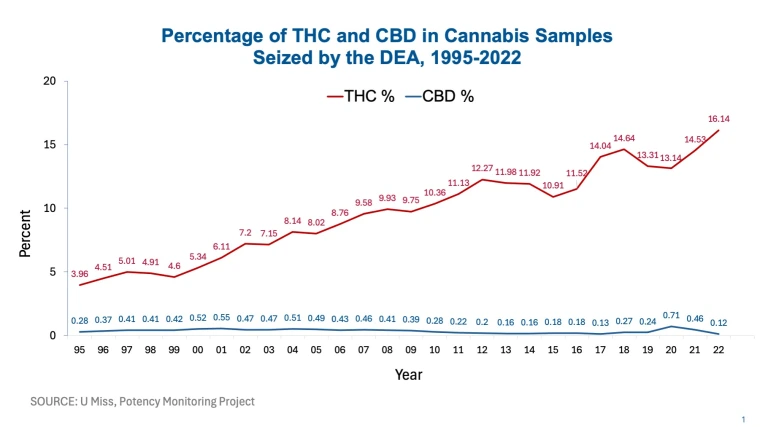Trends in Cannabis Potency (1995–2022)

The chart from the DEA’s Potency Monitoring Project shows a dramatic increase in the average THC (tetrahydrocannabinol) content in cannabis samples seized from 1995 to 2022. In 1995, the average THC percentage was around 3.96%. By 2022, it had increased to 16.14%, marking more than a fourfold increase in potency over 27 years. In contrast, CBD (cannabidiol) percentages have remained consistently low, generally under 0.5%, with a brief spike to 0.71% in 2020.
Trend of High-Potency Products
The cannabis market, especially in states with legalized medical or recreational use, has shifted toward high-potency products, including:
Concentrates like wax, shatter, and oils that can exceed 70–90% THC.
Potent flower strains that now regularly contain THC levels above 20%.
Products marketed for rapid or intense effects, which may be more appealing but come with greater health risks.
This reflects both consumer demand for stronger effects and commercial strategies aimed at product differentiation and perceived value.
Concerns for First-Time Users
The substantial increase in THC potency poses particular risks for first-time or inexperienced users. Higher concentrations of THC are associated with:
Increased risk of acute psychiatric effects, such as anxiety, paranoia, panic attacks, and in some cases, psychosis—especially in individuals with a predisposition to mental health conditions.
Stronger psychoactive effects leading to impaired judgment, motor skills, and coordination, which increases the risk of injuries or accidents.
Delayed onset of effects with edibles or concentrates can cause users to consume more than intended, resulting in overdose symptoms such as severe anxiety, confusion, vomiting, or hallucinations.
Patient Safety Information
Given these trends, the following safety recommendations are important, especially for new or medically-guided cannabis users:
Start low, go slow: Begin with low-THC products and titrate slowly to assess tolerance and minimize adverse effects.
Choose balanced products: Opt for products with a CBD-to-THC ratio of 1:1 or higher, as CBD can mitigate some of THC’s psychoactive effects.
Avoid high-potency concentrates unless medically necessary and under professional guidance.
Store cannabis products securely, out of reach of children and pets, as accidental ingestion can be dangerous.
Avoid mixing with alcohol or other sedatives, as interactions can intensify cognitive and motor impairment.
Know the signs of overuse: Seek medical help if symptoms like extreme confusion, hallucinations, chest pain, or vomiting occur.

